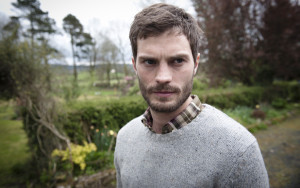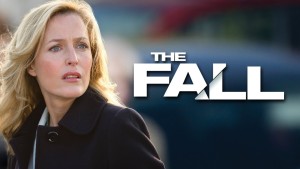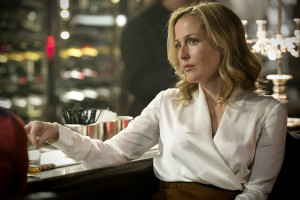“A woman, I forget who, once asked a male friend why men felt threatened by women. He replied that they were afraid that women might laugh at them. When she asked a group of women why women felt threatened by men, they said, ‘We’re afraid they might kill us.’” – DSI Stella Gibson, The Fall
Often when I’m watching a crime show on television, I worry that Gloria Steinem might swoop into my living room and snatch away my Official Feminist Card™. I’ve always been intrigued by solving mysteries, and am often drawn to television series of that genre. But the downside to this particular fascination is that these shows are not particularly kind to women. Best-case scenario, the fairer sex is depicted as the semi-competent and often imperiled sidekick to the macho male detective. Worst-case scenario, she is an anonymous and sexualized victim, merely a prop to move the story along or to make the killer look more powerful. Even on shows with a female lead who wields some actual authority, such as Olivia Benson on Law & Order: Special Victim’s Unit, the underlying (and very intentional) titillating nature of the crimes adds an ick factor I just can’t get past.
The BBC series The Fall is something altogether different. It is the first truly feminist crime drama – and that is something worth noting. Other than just being a stellar show, The Fall charters very new territory by featuring a fully realized female lead investigator, humanized female victims, and a perpetrator who is very clearly nothing more than a garden-variety misogynist.
The Cop
The stunning, fearless, and furiously badass Detective Superintendent Stella Gibson is a character never before seen on television. Played by the sublime Gillian Anderson, Gibson is a member of the Metropolitan Police, brought in by law enforcement in Belfast, Northern Ireland to consult on the high-profile murder of a woman named Alice Monroe. It is Gibson, luminous in her icy cool silk blouses, who is the first to make the connection between the Monroe case and other killings in the city. It is she who realizes there is a serial killer hunting the streets of Belfast. It is she who is going to find him, and she will do it while quoting Margaret Atwood, looking flawless under fluorescent lighting, and drinking red wine while wearing a white shirt. Like a boss.
I applaud the creators of the The Fall for resisting the urge to do what too many other shows do with a powerful female crime-fighter, which is to make her either a Barbie doll running after perpetrators in a skin-tight skirt and stilettos, or a masculine caricature in a no-nonsense ponytail and rumpled clothes. The most feminist aspect of this series is not that the lead detective on a major case is a woman, but that the woman is allowed to be feminine, a sexual being on her own terms and excellent at her job. You know, kind of like real women all over the world. What a concept!
The Victims
Second only to the glory that is DSI Gibson is the remarkable job The Fall does of humanizing the killer’s victims. Very little of the actual murders are shown, and death is not played for thrills. What we do see is certainly horrifying, but through some kind of ingenious magic, this show manages to keep sex and violence from intermixing, allowing for not one single gratuitous shot. We get to see the women before they meet their brutal fates. Their deaths are scary and painful, not exciting. They are human losses rather than plot points.
There is no doubt that The Fall takes an openly progressive stance on the portrayal of female victims in the larger social consciousness. One of the most glorious moments of the show occurs when Gibson’s male colleague refers to the victims as “innocent.” Gibson, having none of it, replies:
“Let’s not refer to them as innocent. What if he kills a prostitute next or a woman walking home drunk, late at night, in a short skirt? Will they be in some way less innocent, therefore less deserving? Culpable? The media loves to divide women into virgins and vamps, angels or whores. Let’s not encourage them.”
I actually stood up in my living room and applauded for that one. The one thing this series did not do that I wish it had is widen the scope in terms of race and socioeconomic status of the victims. But one step at a time, I suppose.
The Killer
 Photo: BBC/Artists Sudio/Steffan Hill
Photo: BBC/Artists Sudio/Steffan Hill
Finally, there is the killer himself. The most interesting narrative element of this series is that there are two parallel stories going on: One focuses on Gibson and her team, and the other focuses on the murderer. We as the audience know who he is from the very first episode, and we watch his every move just as we watch the detectives hunting him. His name is Paul Spector (Jamie Dornan), a middle class husband and father who works by day as a bereavement counselor. It’s not an accident that the show’s creators made their killer an otherwise unremarkable family man. It’s apparent through many such techniques employed on The Fall that the violence portrayed is a clear analogy for all violence against women. After all, it’s not the psychopathic stranger lurking in the shadows who poses the largest threat to women. It’s their husbands, boyfriends, fathers, dates, colleagues, friends – average men living average lives. Spector’s violence is of course especially grotesque, but the normalcy of his existence very purposefully draws the metaphor between his crimes and all crimes by men against women.
During the cat-and-mouse game played by detective and killer throughout the show, Gibson speaks to Spector (still unaware of his identity) over the phone. She listens patiently as he spins some bullshit psuedo-philosophy about his crimes, and when he’s finished, she lays down the truth about him and about all men who hurt women:
“You’re weak. Impotent. You think you’re some kind of artist, but you’re not…You try to dignify what you do, but it’s just misogyny. Age-old male violence against women.”
Crime shows are certainly not going away, so the antidote is clearly that more of them be as progressive as this one. The inherent feminism of The Fall is not about pushing an agenda, but rather changing the focus when it comes to the depiction of violent crimes as entertainment. I’m all for artistic freedom, and I do not think it’s the responsibility of art to correct social ills, but with rampant male violence against women happening in real life all over the world, it feels reckless to create art that glorifies a killer more than it humanizes his victims. The Fall stands as a shining example that a show can be both a riveting crime drama and not degrade over half the world’s population. Here’s to hoping it’s the first of many.






